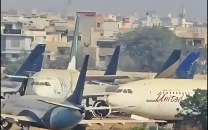'I miss seeing my parents': Blinded by pellets at 14 in IoK
'When I saw Insha, all I could see was her face covered in blood,' said victim's mother

Doctors described Insha Mushtaq's case as the worst they had ever seen
PHOTO: AL JAZEERA
Her fault? She had opened a window to look at the protests raging against the killing of Burhan Wani, in the village Sedow, when the police fired a volley of iron pellets indiscriminately. The iron pellets hit Insha in the face, skull and eyes, blinding her.
"I just peeped through the window and the policemen, who were outside, targeted me. I fell down and I don't know what happened to me after that. Everything went dark," she tells Al Jazeera.
Pakistan protests killing of 5 civilians in Indian shelling
Family members, especially her mother Afroza Bano, have been shattered by the injury inflicted on her. "I remember when she was hit, the window panes shattered and fell to the floor. When I saw Insha, all I could see was her face covered in blood," the 42-year-old says.
"It was as if an earthquake had struck us. Everyone stood frozen for a moment, unable to grasp what had just happened. I removed my headscarf and wiped the blood from my daughter's face. We shouted for help. At that moment, the electricity went off. Everything became dark," says Bano, echoing her daughter's words.
Fearing that she had been hit by a bullet, the family rushed her to the District Hospital in Shopian, where doctors referred her to a Kashmir's tertiary care hospital in Srinagar. The young girl bled profusely during the nearly 65km journey to Srinagar, the regional capital.
Due to the multiple pellet injuries, Bano says, the doctors could not stop her bleeding. "It took us two hours to reach Srinagar hospital, where we heard of pellets for the first time," says Bano. Hundreds of patients were there already, grappling with similar injuries.
In September, Amnesty International released "Losing Sight in Kashmir: The Impact of Pellet-Firing Shotguns" - a comprehensive report documenting 88 cases of victims, mostly in their teens and early 20s, who were hit in their eyes during the 2016 uprising. Amnesty has urged security forces to stop the use of pellet-firing shotguns immediately "in line with international human rights standards on the use of force".
"By their very nature, the weapons have a high risk of causing serious and permanent injuries to the persons targeted as well as to others (bystanders). These risks are virtually impossible to control," said Shalesh Rai, a member of Amnesty International India, in a press conference on September 13.
Insha, now 16-years-old, is one of the hundreds of teenagers who have become victims of the dreaded pellet guns'. Her face was pockmarked with more than hundred pellet wounds; some hit her eyes, some pierced close to her brain. Her nasal, frontal, and maxillary bones were also broken.
The doctors treating her at the Surgical Intensive Care Unit of Srinagar's Maharaja Hari Singh Hospital (SMHS) had a grim diagnosis; procedures to try to restore her eyesight were unsuccessful. They described her case as "the worst we have ever seen", as they focused on protecting her brain. She was noted down as blind for life.
Having once dreamt of becoming a doctor, she now spends her day in the confines of her parents' two-room house in the quiet Sedow village on the southern edge of Kashmir valley. She is completely dependent on her mother to eat, pray, or visit the toilet. Her cousins occasionally help her go to school or visit friends.
Indian troops shell IOK college, wound 50 students
"My days and my nights are the same," she said. "It is only when I hear the azaan that I make a guess about the time," she says, sitting nervously in an upstairs room where she spends most of her day. To help her realise her dream, three teachers from her village visit her every day to continue her studying. But it's a struggle. "They give me oral lessons," she says praising their patience and gesture. "I have to remember everything. I try my best but it is not that easy. I don't know how long I can do this."
Naveed Ahmad, one of her teachers, said lessons can become challenging. "Her moods change very frequently. One moment she might be willing to study, but a moment later she refuses to be taught anything," he says. She puts on a brave face, her mother says, but there are times when she breaks down and cries. "I want to go to school and study like I did earlier. I am living a miserable life," she says. "I have adopted Braille and also use some equipment to study, but there is no electricity in the village most of the time."
"I miss my parents. I miss seeing them… I long to see my two younger brothers growing." Her expressions toss between sudden smiles and straight sullen faces. "I sometimes want to see my face; I know my face was disfigured due to the pellets … I am not only blind but my eyes are blocked."


















COMMENTS
Comments are moderated and generally will be posted if they are on-topic and not abusive.
For more information, please see our Comments FAQ